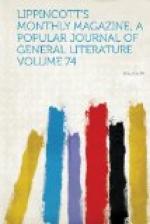“There he is—that’s the man!” said the homoeopathist, much excited, and indicating to the blue coat a brisk, capable-looking gentleman of thirty-two in a neat silver-gray overcoat. The latter, after slightly touching his nose, nodded to the Scotchman, who in return drew himself up to his full height and formally wiped his mouth with a napkin, as if preparing himself for an ovation. Happily, he contented himself with rubbing his own nose with each hand in turn, and bowing so profoundly that he appeared ready to break at the knees.
“Kellner!” said the silver-gray, making a grand rattle among the plates and glasses, “some wine! some water! some ink! an omelette! a writing-pad! a filet a la Chabrillant!”
The last-named dish is one which Sciolists are perpetually calling filet a la Chateaubriand, saddling the poetic defender of Christianity with an invention in cookery of which he was never capable. I approved the new-comer, who was writing half a dozen notes with his mouth full, for his nicety in nomenclature: to get the right term, even in kitchen affairs, shows a reflective mind and tenderness of conscience. My friend the engineer arrived, and placed himself in the chair I had turned up beside my own. I was ashamed of the rate at which I advanced through my capon, but I recollected that Anne Boleyn, when she was a maid of honor, used to breakfast off a gallon of ale and a chine of beef.
My canal-maker interrupted me with a sudden appeal. “Listen—listen yonder,” he said, jogging my knee, “it is very amusing. He is in a high vein to-day.”
The gray coat, who had already directed four or five letters, and was cleaning his middle finger with a lemon over the glass bowl, had just opened a lofty geographical discussion with the bluebottle. I cannot express how eagerly I, as a theorist of some pretension in Comparative Geography, awoke to a discussion in which my dearest opinions were concerned.
“Geography,” the active gentleman was saying as he dipped his finger in water to attach the flaps of his envelopes—“geography, my dear professor, is the most neglected of modern sciences. Excuse me if I take from under you, for a moment, your doctoral chair, and land you on one of the forms of the primary department. I would ask a simple elementary question: How many parts of the globe are there?”
“Before the loss of Alsace and Lorraine,” said the professor with plaintive humor, “I always reckoned six.”
“Very well: on this point we agree.”
“Six!” said the Scotchman in great surprise. “You are liberal: I make but five.”
“Not one less than six,” said the patriot, vastly encouraged with the support he got: “am I not right, sir? We have, first, Europe—”
“Ah, professor,” said the silver-gray, interrupting him, “how is this? You, such a distinguished scholar—you still believe in Europe? Why, my dear sir, Europe no longer exists—certainly not as a quarter of the globe. It is simply, as Humboldt very truly remarks in his Cosmos, the septentrional point of Asia.”




